Last Updated on October 21, 2025 by Maika Cotton | Published: October 10, 2018
We’re big advocates for living like a local through travel. In our opinion, there’s no better (or more delicious) way to do that than by visiting a neighborhood market.
And luckily, there’s no shortage of fantastic Madrid food markets, Barcelona food markets, San Sebastian food markets, Seville food markets, Valencia food markets…the list goes on! No matter what corner of the country you find yourself in, you’re bound to encounter some great local Spanish food markets.
That being said, read on to discover all the secrets of navigating Spanish food markets like a pro.
There’s really no bad time to go to the market—it just depends on what you prefer!
Spanish food markets provide one of the most authentic glimpses of life in any given city or town. It’s here where locals buy their groceries and restaurant owners stock up on fresh ingredients. Everything is purchased from proud vendors who, in many cases, are carrying on a family tradition of selling their products.
Even the markets that seemingly lean towards the touristy side (we’re looking at you, Mercado de San Miguel) carry a long legacy. But to really get to know Madrid, head off the beaten path into a neighborhood market.
Ready to shop (and eat)? This guide to navigating Spanish food markets will show you everything you need to know to brave the crowds and eat like a local.
Spanish market vocabulary
While there’s always a chance that market vendors will speak English, it’s always best to err on the side of caution and brush up on your Spanish before you go. These useful words and phrases will help you make your way through even the most off-the-beaten-path Spanish food markets.
- ¿Cuánto cuesta? How much does it cost?
- Ponme… Give me…
- Un kilo: One kilo
- Medio kilo: Half a kilo
- Cuarto kilo: Quarter of a kilo
- Una docena: One dozen
- El pesacado: The fish
- La carne: The meat
- El queso: The cheese
- El pan: The bread
- La fruta: The fruit
- Las verduras: The vegetables
- Una bolsa: A bag
When in doubt, don’t be afraid to resort to hand gestures. Most market vendors are friendly, personable folks who pride themselves on great customer service. They’ll be happy to help you even if you can’t find the words.
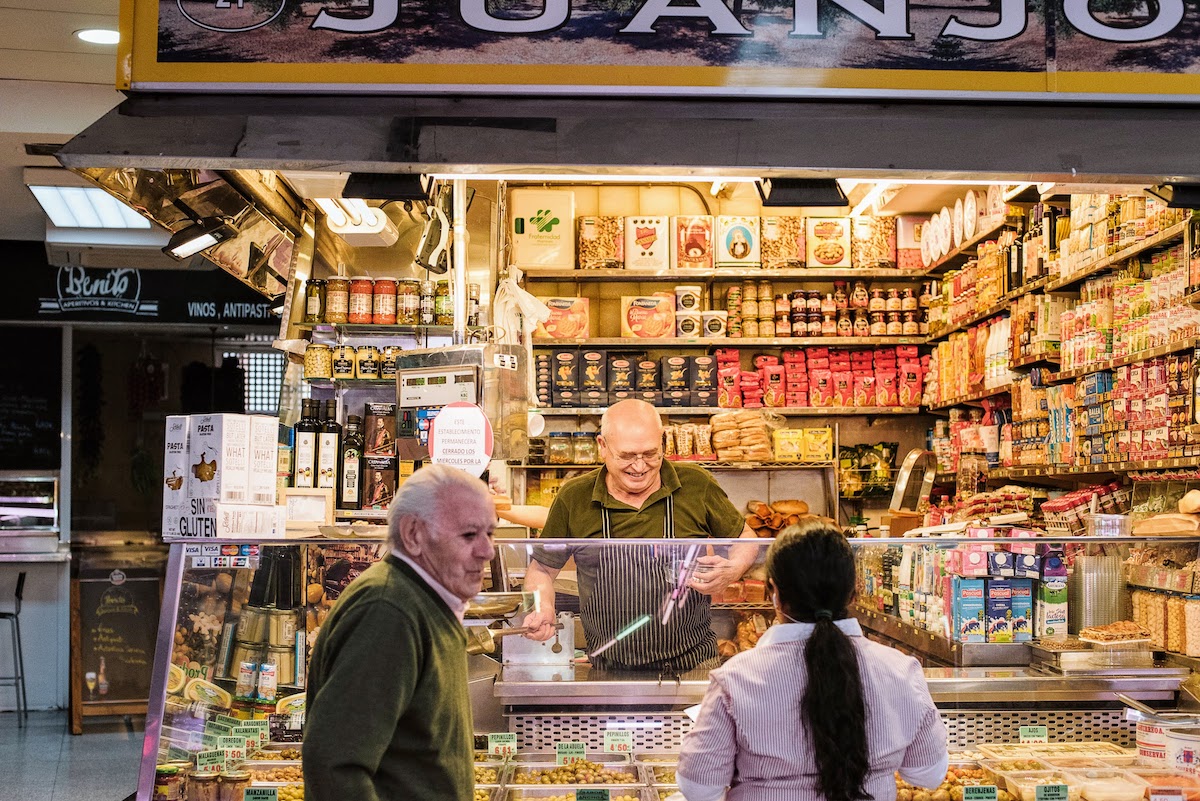
When to go to a Spanish food market
As a general rule, many Spanish food markets (especially those located in more central areas of large cities) tend to get more crowded as the day goes on. If you want to beat the crowds, stop in first thing in the morning as the vendors are setting up their stalls for the day. You’ll be able to enjoy the peace and quiet as you shop amongst a handful of locals getting their errands out of the way and chefs purchasing the day’s fresh ingredients.
If you’re in Madrid, the best day of the week to visit a market is easily Saturday. Yes, it will be more crowded, which seems counterintuitive to our previous point. However, it’s when markets truly come alive with fun events and many vendors give out free samples like they’re going out of style.
Ultimately, it all depends on what you’re looking for. Would you like to explore the market calmly without pushing your way through crowds? Or do you want a bustling, active environment that’s a true feast for all five senses?
One important rule of thumb: Don’t head to the market on Mondays if you need to buy fish. Fresh fish doesn’t usually come into the markets on Sunday, so by the time Monday rolls around, any fish that is available will often be several days old. Wait until Tuesday to get your seafood fix!
As far as what time of day to go—well, that also depends on what you’re looking to do! If you want to shop, get there in the morning, because stalls tend to close at lunchtime. However, just as those are closing up, the market bars and restaurants are just getting started. Stop by and grab a bite for lunch, or later in the evening for dinner.
How to shop at markets in Spain
Getting to the market: check. Now it’s time to shop! But how can you spot the best stalls with the highest quality products, especially if you’re new in town?
Your best bet is to take a lap around the market and keep your eyes peeled. Is there a line? That’s usually your first giveaway that a stall is particularly good.
Before you hop in line and take a ticket (more on that in a bit), be sure that the stall has whatever it is you’re looking for. Here in Madrid, for example, meat and chicken are usually sold in separate stalls: carnicerías and pollerías, respectively. This is not often the case in other places, like Seville.
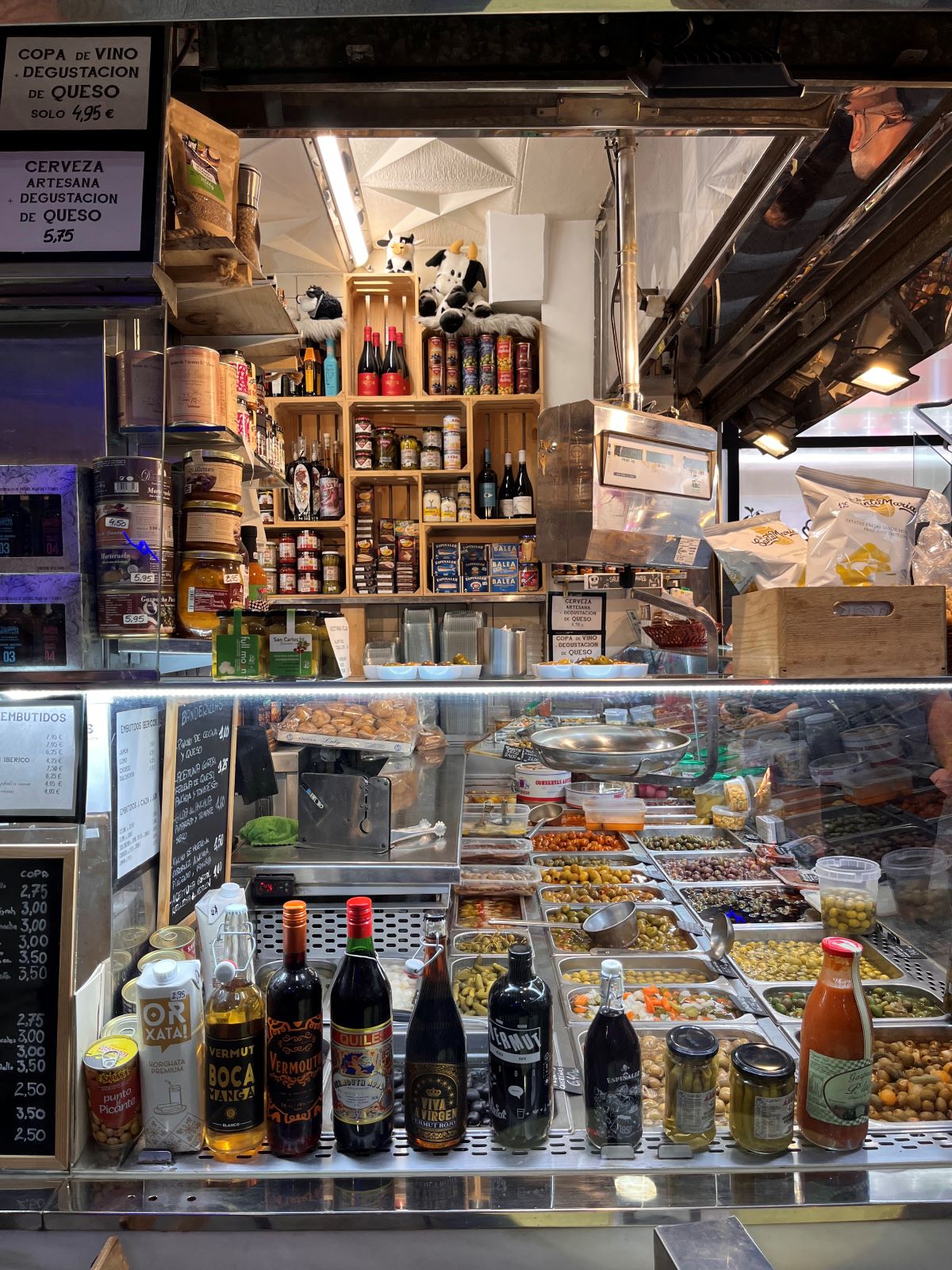
Once you’ve narrowed it down, observe what the locals are buying. Does everyone seem to be getting the same or similar products? That might be the vendor’s specialty.
If it’s not immediately clear, take a number and when it’s your turn, ask the vendor for their recommendations. And don’t be afraid to ask for a small taste so you can sample it before you buy.
If you’re at a produce stand, remember that fruits and vegetables tend to be pretty seasonal here. Don’t expect to see strawberries in chilly November, or bright orange squash past fall.
Finally, don’t skip the charcuterie stalls thinking that you can get the same thing at any tapas bar. You can, but delicacies such as jamón and cheese tend to be much cheaper at market stalls than at an outside bar, considering that you’re buying them straight from the source. Stock up while you’re at the market!
Purchasing food at a market stall
So you’ve found a promising-looking stall where locals are lining up. But how do you know when it’s your turn, and how do you even go about ordering, anyway?
No worries. In many cases, you’ll need to take a numbered ticket (hint: it looks like our logo!) and wait to be called. When it’s your turn, make your way up to the counter.
Keep in mind that most products are ordered by weight in kilos. If you’re from the US or another country that measures weight in pounds, it may help to remember that one kilo is about 2.2 pounds.
Spanish food market etiquette
Respecting the products as well as the vendors themselves is an important part of being a responsible traveler. Perhaps most importantly, don’t touch the products—even if you’re trying to be helpful by grabbing whatever you need yourself.
Also, while colorful markets are prime Instagram material, don’t whip out your phone or DSLR just yet. Politely ask the vendor before taking pictures of them or their products.
Finally, remember that the market is not a museum. Vendors are locals earning an honest living for their families. Browsing for a little bit while you think of what you might want to buy is fine, but please do purchase something!
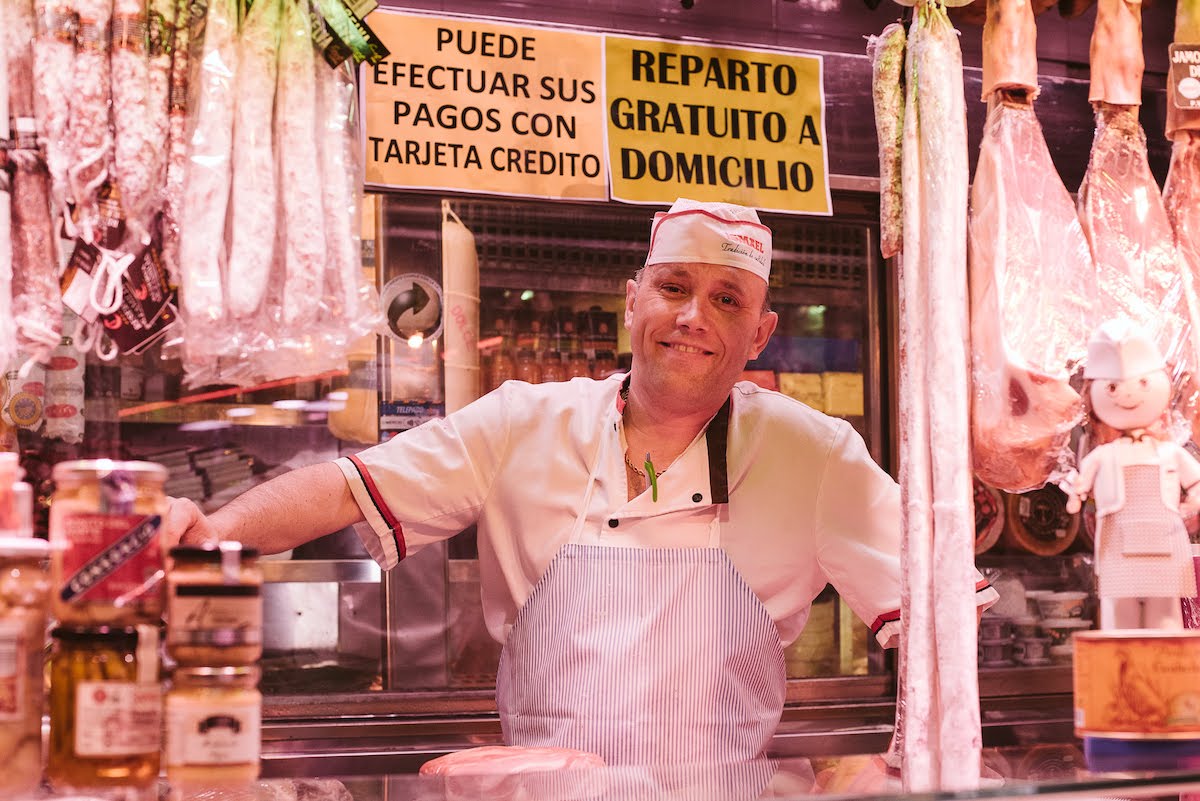
For centuries, Spanish food markets have been about more than just gastronomy. They’re gathering places for friends and family to get together, shop, and grab a bite to eat or some drinks.
Our final tip: After exploring the market and buying whatever it is you need, stick around and enjoy a beer at one of the market bars. It’s a great way to relax and people-watch once you’re finished shopping. Sit back and enjoy a time-honored foodie tradition!
Spanish food markets FAQs
Spain’s best-known food markets are the Mercado de San Miguel in Madrid and the Boqueria in Barcelona. However, both cities offer plenty of more authentic, local alternatives. Check out Mercado Antón Martín in Madrid, or Mercat Santa Caterina in Barcelona.
The largest food market in Spain—and in fact, in all of Europe—is Valencia’s Mercado Central.
Update notice: This post was updated on September 19, 2023.
Join us for our Ultimate Spanish Cuisine Tour of Madrid, where you’ll have the chance to explore one of the city’s most charming local markets, expertly guided. Meet the vendors, savor local delicacies, and delve into the rich history behind these quintessential products.

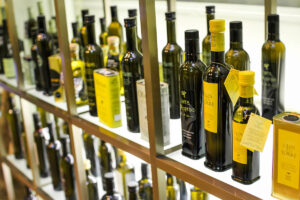
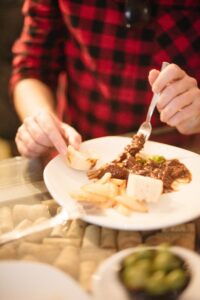






very interesting but Malaga is my choice of city
And they have an amazing market!! We love Atarazanas!
I’m in Madrid now. Are all markets inside? It’s also sad to see now streets food vendors. Not much happening on the streeet o terms of food.
Correction
It’s also dad to see no street food vendors.
And it’s a beautifull city. It sounded too negative. It’s just one sad thing in a beautiful city.
Hi René—while most markets in Madrid nowadays are indoors, there are some (like the Antón Martín market) that have a partially outdoor setup as well. Street food is a relatively new trend in Madrid, so we’ll surely start to see even more vendors out and about in the future!
A few weeks ago I tried Spanish food for the first time, and ever since I became a huge fan so I´m looking for advice to buy the right food at a market that might help me to determine what restaurants are good or not. It´s interesting to know what are the most used fruits or vegetables, and how to determine what´s in season. I will definitely have it in mind so I know what is best to cook or when it´s best to go to a restaurant.
Hi Megan, we’re so glad you want to incorporate more Spanish food into your life! Seasonal eating is definitely the way to go when it comes to cooking in Spain, so check out what’s in season in your area (here in Spain, October and November are prime time for root vegetables, citrus fruits and apples!). For restaurants, keep an eye out for places that change their menus frequently to reflect the best seasonal products, as this will help ensure that whatever you order is of the highest quality. We hope this helps!